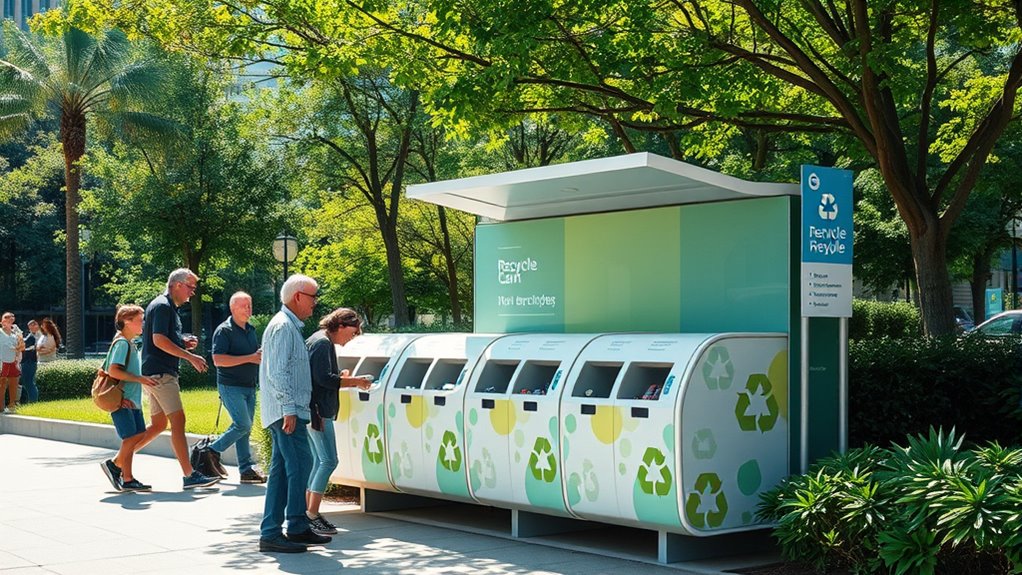Eco-nudges are subtle environmental cues designed to influence your daily choices and promote sustainable actions effortlessly. By making eco-friendly options more visible, accessible, and appealing—like placing recycling bins nearby or using encouraging signage—they leverage natural tendencies to choose the easiest or most attractive choice. These cues reinforce the importance of individual habits in protecting the environment. If you explore further, you’ll discover how thoughtful design can shape sustainable behaviors in everyday life.
Key Takeaways
- Incorporate subtle cues like signage or environmental tweaks to make sustainable choices more visible and accessible.
- Use positive messaging and quick facts to connect actions with ecological benefits and motivate behavior change.
- Position eco-friendly options at eye level or in prominent locations to leverage natural tendencies toward the easiest or most visible choices.
- Embed nudges seamlessly into environments to reinforce sustainable habits without coercion or heavy regulation.
- Align eco-nudges with personal values to enhance motivation and foster consistent, long-term environmentally conscious behaviors.

Have you ever wondered how small changes can lead to big environmental impacts? The concept of eco-nudges revolves around subtle cues and tweaks in your environment that influence your behavior without forcing you or relying on heavy-handed regulations. These small interventions leverage behavioral incentives—positive or negative triggers that motivate you to act more sustainably. When designed thoughtfully, eco-nudges can substantially boost your environmental awareness and encourage eco-friendly choices in everyday life. You might not even realize it, but the way a product is displayed, the placement of bins, or the wording on a sign can shape your habits and perceptions about sustainability.
Imagine walking into a cafeteria where the most sustainable options are placed at eye level or highlighted with appealing signs. This simple adjustment acts as a behavioral incentive, nudging you toward eco-friendly choices without restricting your freedom. Such strategies tap into your natural tendencies—like choosing the easiest or most visible option—making it easier for you to make environmentally conscious decisions. When you see messages emphasizing the positive impact of recycling or conserving water, your environmental awareness increases. This heightened consciousness makes you more likely to adopt sustainable behaviors consistently because it connects your daily actions to larger ecological benefits.
Eco-nudges work best when they’re seamlessly integrated into your environment, subtly shaping your habits over time. For example, placing recycling bins in prominent locations encourages you to sort waste correctly, reinforcing the idea that your actions matter. Signage that provides quick facts about energy savings or water conservation can spark your curiosity and motivate you to change behaviors. When these nudges are aligned with your values and understanding, they reinforce your sense of agency and responsibility toward the environment. They don’t demand drastic changes but instead make the sustainable choice the easiest, most attractive option available. Recognizing the importance of sustainable materials in product design can further enhance the effectiveness of eco-nudges by promoting environmentally friendly choices.
Frequently Asked Questions
How Do Eco-Nudges Differ From Traditional Environmental Policies?
Eco-nudges differ from traditional environmental policies because they leverage insights from behavioral economics to subtly influence your choices without restricting options. Instead of mandates or fines, eco-nudges design policy to subtly encourage sustainable behavior through cues and defaults. You’re guided towards eco-friendly actions naturally, making it easier to adopt green habits. This approach focuses on policy design that nudges your behavior, rather than imposing strict regulations.
Can Eco-Nudges Be Ethically Implemented Without Manipulation?
While eco-nudges can be ethically implemented, you should always consider moral considerations and prioritize transparency in implementation. By openly communicating the purpose of nudges and ensuring they respect individual autonomy, you avoid manipulation. This approach fosters trust and aligns with ethical standards, allowing you to influence sustainable behavior positively without crossing moral boundaries. Ultimately, thoughtful, transparent design helps you promote environmental benefits responsibly and ethically.
What Are the Most Effective Eco-Nudge Strategies in Urban Areas?
In urban areas, you can use eco-nudges like placing recycling bins in prominent public spaces and using visual cues to encourage eco-friendly choices. Engaging the community through events and local campaigns boosts participation and awareness. These strategies work best when they make sustainable actions easy and visible, fostering a sense of shared responsibility. By involving residents directly, you create a culture of sustainability that’s both effective and ethically sound.
How Do Cultural Differences Impact Eco-Nudge Effectiveness Worldwide?
Think of eco-nudges as a universal language, but cultural perceptions shape how they’re received. In Japan, community harmony fosters behavioral adaptation to recycling nudges, while in the US, individualism may require different cues. Your approach must respect these differences, tailoring messages that resonate locally. Recognizing cultural nuances guarantees eco-nudges are effective, prompting sustainable actions that align with diverse values and perceptions worldwide.
Are There Measurable Long-Term Impacts of Eco-Nudges on Behavior Change?
You can see measurable long-term impacts of eco-nudges through behavioral measurement, which tracks sustained changes over time. These nudges promote long-term sustainability by influencing habits beyond immediate reactions. While some effects fade, well-designed eco-nudges can foster enduring behavior change, especially when combined with ongoing reinforcement. By analyzing data over extended periods, you’ll find clear evidence of lasting impacts, confirming that eco-nudges can contribute markedly to sustainable living habits.
Conclusion
Imagine guiding your actions like a gentle breeze steering a boat toward greener waters. Eco-nudges are your compass, quietly influencing choices and steering you toward sustainability without resistance. By designing these subtle prompts, you become the artist shaping a vibrant, healthier planet—one mindful decision at a time. Embrace these eco-friendly whispers, and watch your habits bloom like a garden in spring, transforming the world around you into a thriving, sustainable paradise.








